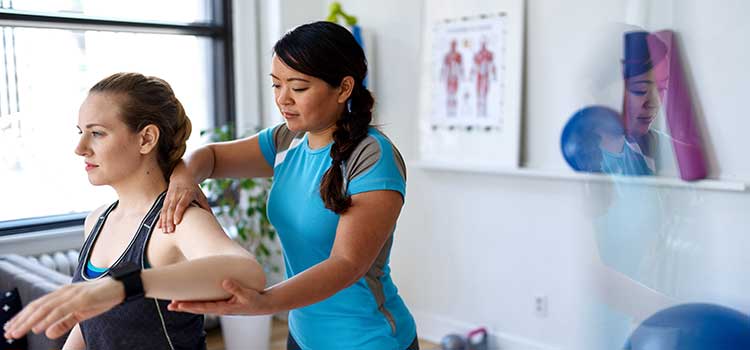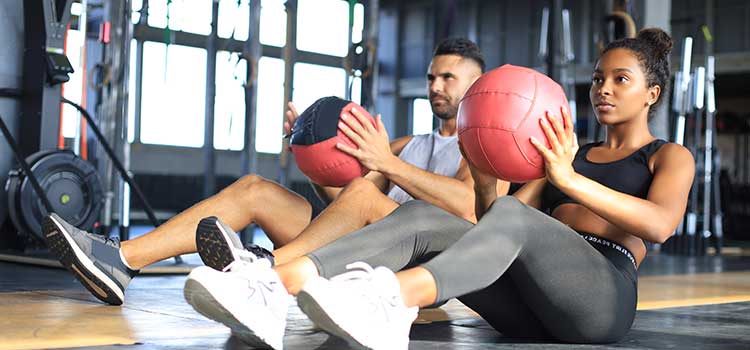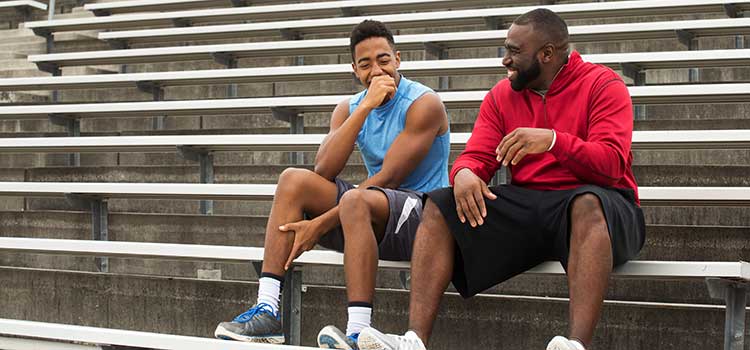How to become an athletic trainer—Steps, job duties, education & salary

What is an athletic trainer?
They rush the field when an athlete suffers an injury during a game, treat a marathon runner’s ankle so she can get back on track, and even facilitate exercises with physical laborers to prevent workplace injuries.
Athletic trainers are multi-skilled health professionals that treat the unique health needs of athletes. They collaborate with athletes’ physicians to treat injuries, facilitate rehabilitation and provide preventative care.
“We are healthcare providers. We are experts in concussions, athletic injuries, rehab and general medical conditions. We have this plethora of knowledge and education,” said Erin Krauth, Manager of the Seattle Children’s Hospital’s Athletic Training Program.
Athletic trainers should not be confused with the role of physical therapists. Although both occupations treat injuries and do rehabilitation with patients, their education is very different. Athletic trainers primarily treat athletes and health problems related to athletics, while physical therapists treat a wider clientele.
6 steps to becoming a certified athletic trainer
Determine if athletic training is a good career fit for you

Do you have a desire to help and heal people? Are you passionate about health and wellness as well as sports and athletics? Are you willing to pursue a master’s degree in your field?
Your answers to these questions may help you determine if athletic training is a good career fit for you. For instance, obtaining a master’s degree takes a good deal of commitment in terms of time and money. Before making that investment, it’s important to ensure that you’re comfortable with the salary level of the career you hope to enter with that degree.
Earn a bachelor’s degree in a related field

Earning a bachelor’s degree is the first step to getting your master’s in athletic training. Choosing a degree in a closely related field such as sports medicine or exercise science will prepare you well for a master’s degree program.
Earn a master’s degree in athletic training

Programs must be accredited by the Commission on Accreditation of Athletic Training Education (CAATE) in order to sit for the Board of Certification exam. Each master’s degree program has its own prerequisites—some may require that students entering the program have completed a certain amount of hours job shadowing, for example. Check with schools for more information on their prerequisites.
Pass the Board of Certification exam

The Board of Certification (BOC) is the only accredited athletic trainer certification program out there. Once you take and pass the BOC exam, you have one year to complete your BOC profile to obtain your certification. BOC recommends that you complete these extra steps before exam results are posted to speed up the process.
Apply for an athletic trainer license in your state

Although every state has their own licensing requirements for athletic trainers, most require that you have an accredited degree in athletic training and have passed the BOC exam.
Apply for athletic trainer jobs in a work environment that interests you

Now that you’ve obtained your athletic trainer license, you are ready to enter the workforce. Athletic training jobs are available in hospitals, schools, colleges and universities, sports medicine offices, and much more.
What do athletic trainers do?
Athletic trainers provide healthcare to athletes to help them to perform as close to peak physical function as possible. According to At Your Own Risk, an educational website developed by the National Athletic Trainers’ Assocation (NATA), they are trained in the prevention, examination, diagnosis, treatment and rehabilitation of medical conditions and emergent, acute and chronic injuries. They understand the unique physical demands on an athlete’s body and cater their treatment to those demands.
An athletic trainers job description includes working with athletes in the following ways:
What being an athletic trainer is like (according to an expert)
“That’s part of the reason I love this job, it’s just so different every day and there is no routine,” said Cari Wood, Athletic Trainer and Northwest Athletic Trainers’ Association Hall of Fame member, who works with secondary school athletes at a high school in Redmond, Oregon.
Not all their care is reactive—athletic trainers also work with their athletes to prevent future injuries by:
- Assessing physical ailments.
- Advising athletes on how to prevent injuries and ailments from worsening.
- Assisting with exercises.
- Akin to the role of a personal trainer, they work to strengthen parts of their client’s body that may be prone to injury.
- Educating athletes.
- Teach best practices to keep their body fit and healthy.
- Implementing nutrition guidelines.
- Help institute standards and habits around proper nutrition—and refer client’s to a licensed RND professional if need be.
“You come in and try to get some time in your office before athletes come in, because we’re doing documentation and physician follow up calls. In my setting we do a lot of parent contact because we’re working with minors, so there’s a lot of parent phone calls, working on administrative type stuff. And then the athletes start coming in depending on what the schedule is like for every sport. Once you get through your day-to-day treatments and longer-term rehabs, we try to stop in at every practice and catch up and talk with the coaches. We’re also there to provide healthcare at the games in case of emergencies,” Wood said.
Where do athletic trainers work?
Just about every institution with an athletic component needs athletic trainers.
“As a medical career it’s so unique from other health professionals just because there’s so many different settings that athletic trainers can work in,” Wood said. “When someone studies athletic training, you can pretty much mold your career based on what you would like your patient population to be, what you would like your daily schedule to look like.”
Professional sports teams only make up a fraction of the athletic trainer jobs out there—only two percent according to NATA. In reality, the largest employers of athletic trainers, according to the U.S. Bureau of Labor Statistics (BLS), are:
- Educational institutions:
- State, local and private schools at all levels have need of athletic trainers. Athletic trainers work with student athletes from primary school through college.
- Hospitals:
- Many athletic trainers work directly at hospitals to provide care to patients that are admitted with sport and athletic-related injuries.
- Offices of physical, occupational and speech therapists, and audiologists:
- Some athletic trainers work in sports medicine or physical therapy offices. They may receive patients who are referred by hospitals or schools, or who seek out their services independently.
- Fitness and recreational sports centers:
- By employing athletic trainers, these businesses have a qualified health-care professional available to provide care to their customers.
- Self employment:
- Some athletic trainers choose to open private practices, which can give them more flexibility since they are less defined by the environment in which they work.
While the workplaces listed above represent some of the most common employers of athletic trainers, myriad other industries and facilities require their services.
“One type [of athletic trainer] that is pretty big here in Seattle is industrial athletic training, and that is working with industrial laborers,” Krauth said. “The Boeing factory here employs a lot of athletic trainers through a third-party group. They do preventative work and rehab with industrial laborers that are doing a lot of repetitive motions and a lot of physical work for their jobs. The goal is to prevent injuries.”
Even the performing arts needs athletic trainers. Dancers, acrobats, Broadway performers and more are all highly athletic, making athletic trainers an asset to have on hand.
“The military is another area that’s really growing because, of course, soldiers are athletes as well, so having someone to work with them and understanding how active they are and getting them back to their position is invaluable,” Wood said.
Before she was the manager of the Seattle Children’s Hospital’s Athletic Training Program, Krauth was a high school athletic trainer for years.
“It’s really fun to work with high school athletes. You get the full spectrum of sports and athletics—with college sports you generally are assigned to one or a couple of teams that you work with all year long, whereas with high school sports you are the one athletic trainer that’s there for all the sports at that school, so there are a wide variety of sports that you are covering. You get the know the kids and the coaches really well and you really get to be a part of the community of the school.”
Athletic trainer education—What you’ll study
Athletic trainers must earn a degree in athletic training from a CAATE-accredited program.
Until recently, there were many bachelor’s degrees available in athletic training. In 2015, the Athletic Training Strategic Alliance changed their accreditation requirements from degrees at the baccalaureate level to the master’s level. This means that existing bachelor’s degree programs in athletic training will either transition to a master’s degree program or will be removed after the Fall 2021 academic year.
Earning a bachelor’s degree in a related subject can prepare you for a master’s degree in athletic training, and might allow you to complete some or all of the prerequisite courses to enter a master’s program. Undergraduate majors that would benefit a career in athletic training can include:
Things to keep in mind when choosing a masters in athletic training
Once you have completed your bachelor’s degree, it’s time to find an athletic training master’s program. Every master’s degree has its own unique prerequisites to be admitted into the program, so it may be helpful to look for a master’s degree program first so that you can determine what is required for admission, and then choose your bachelor’s degree from there. Be sure to check that your master’s program is accredited by the CAATE.
The National Athletic Trainers’ Association lists the following as their essential athletic training education competencies. These components will be present in any CAATE-accredited athletic training program:
Athletic training certification and licensure
Once you have completed or are finishing your degree, you will be eligible to take the Board of Certification exam. Passing the exam grants you your athletic trainer certification.
The Board currently requires that you hold a CAATE-accredited degree in athletic training (earned in 2003 or later) in order to sit for the exam. This is to account for people who already hold or are currently pursuing a bachelor’s degree in athletic training. As stated above, only master’s degree programs will be available moving forward, and therefore will be required to sit for the exam in the future.
However, you’re not quite ready to start practicing as an athletic trainer quite yet – the final step is to apply for licensure in your state. Although licensing requirements do vary by state, there are some common application requirements such as:
Some states have other minor requirements like being CPR certified or taking a child abuse and reporting training course. Be sure to check each state’s individual requirements to make sure you are eligible for an athletic training license.
Median annual athletic trainer salary (state comparison)
Many factors can influence how much you can make as an athletic trainer, such as your location, work setting, education level and experience.
Additionally certain states have higher employment levels than others. Texas, Ohio, Pennsylvania, California, and North Carolina currently employ the most athletic trainers in that order. While Washington D.C., Massachusetts, and New Jersey are the three top paying states for athletic trainers.
Athletic trainer salary vs physical therapist—which is higher? See how athletic training pay compares to the annual salary for a physical therapist.
Athletic trainer job outlook
As the population grows and sports organizations expand, the need for athletic trainers will grow too. The BLS estimates that employment of athletic trainers will grow 14.1% through 2032, much faster than the average across all occupations.
14.1% job growth through 2032 for athletic trainers says the Bureau of Labor Statistics
Another factor influencing this estimate is our emerging understanding of the effects of sports-related injuries, especially concussions. According to the BLS, some states require public secondary schools to employ athletic trainers because they are usually onsite and are often the first responders when injuries occur. Therefore, the demand for trainers in schools is expected to continue to increase as we learn more about the effects of sports-related injuries.

Written and reported by:
Kendall Upton
Staff Writer

With professional insight from:
Erin Krauth, Athletic Trainer
Manager, Seattle Children’s Hospital Athletic Training Program

With professional insight from:
Cari Wood, Athletic Trainer
Northwest Athletic Trainers’ Association Hall of Fame Member
